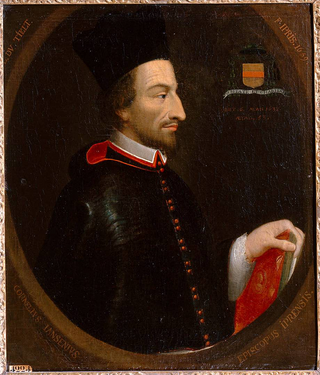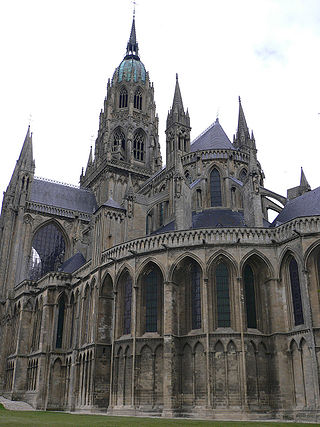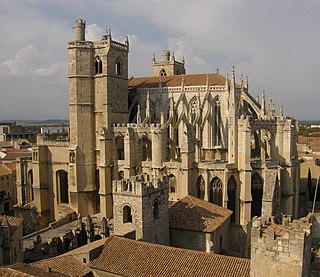
The College of Sorbonne was a theological college of the University of Paris, founded in 1253 by Robert de Sorbon (1201–1274), after whom it was named.

Jansenism was an early modern theological movement within Catholicism, primarily active in the Kingdom of France, that arose in an attempt to reconcile the theological concepts of free will and divine grace. Jansenists claimed to profess the true doctrine of grace as put forth by Augustine of Hippo. In 1653, Pope Innocent X promulgated the bull Cum occasione, which condemned five errors attributed to Jansenism, including the idea that Christ did not die or shed his blood for all men.

Aron Jean-Marie Lustiger was a French cardinal of the Catholic Church. He served as Archbishop of Paris from 1981 until his resignation in 2005. He was made a cardinal in 1983 by Pope John Paul II. His life is depicted in the 2013 film Le métis de Dieu.

William Farel, Guilhem Farel or Guillaume Farel, was a French evangelist, Protestant reformer and a founder of the Calvinist Church in the Principality of Neuchâtel, in the Republic of Geneva, and in Switzerland in the Canton of Bern and the Canton of Vaud. He is most often remembered for having persuaded John Calvin to remain in Geneva in 1536, and for persuading him to return there in 1541, after their expulsion in 1538. They influenced the government of Geneva to the point that it became the "Protestant Rome", where Protestants took refuge and dissidents such as Catholics and unitarians were driven out, some were even killed for their beliefs. Together with Calvin, Farel worked to train missionary preachers who spread the Protestant cause to other countries, and especially to France.

Pierre de Bérulle was a French Catholic priest, cardinal and statesman in 17th-century France. He was the founder of the French school of spirituality, who could count among his disciples Vincent de Paul and Francis de Sales, although both developed significantly different spiritual theologies.
Nicolas Ysambert was a French, Roman Catholic theologian, and lifelong teacher at the Sorbonne.

Bartolomé Carranza was a Navarrese priest of the Dominican Order, theologian and Archbishop of Toledo. He is notable for having been persecuted by the Spanish Inquisition. He spent much of his later life imprisoned on charges of heresy. He was first denounced in 1530, and imprisoned during 1558–1576. The final judgement found no proof of heresy but secluded him to the Dominican cloister of Santa Maria sopra Minerva where he died seven days later.

The Diocese of Gap and Embrun is a Latin Church ecclesiastical territory or diocese of the Catholic Church in Provence-Alpes-Côte d'Azur region of Southern France.

The Diocese of Bayeux and Lisieux is a Latin Church diocese of the Catholic Church in France. It is coextensive with the Department of Calvados and is a suffragan to the Archdiocese of Rouen, which is also in Normandy.

The Colloquy at Poissy was a religious conference which took place in Poissy, France, in 1561. Its object was to effect a reconciliation between the Roman Catholics and Protestants (Huguenots) of France.
Claude de Sainctes was a French Catholic controversialist.
Juan Maldonado was a Spanish Jesuit theologian and exegete.

Adolphe Louis Albert Perraud was a French Cardinal and academician.

The former Catholic diocese of Narbonne existed from early Christian times until the French Revolution. It was an archdiocese, with its see at Narbonne, from the year 445, and its influence ran over much of south-western France and into Catalonia.

Nicolas de Pellevé was a French archbishop and Cardinal. He was a major figure of the Catholic League.

The Archdiocese of Toulouse is a Latin Church ecclesiastical territory of the Catholic Church in France. The diocese comprises the Department of Haute-Garonne and its seat is Toulouse Cathedral. Archbishop Guy de Kerimel has been its head since 2021.

The Diocese of Montauban is a Latin Church diocese of the Catholic Church in France. The diocese is coextensive with Tarn-et-Garonne, and is currently a suffragan of the Archdiocese of Toulouse. The episcopal seat of the Diocese of Montauban is in Montauban Cathedral.

Anton Hubert Fischer was a Roman Catholic Archbishop of Cologne and cardinal.
Honoré Tournély was a French Catholic theologian. He was a Gallican opponent of Jansenism.

Gaspard Mermillod was a Swiss Cardinal of the Roman Catholic Church. Despite a lengthy investiture conflict with the Calvinist Canton of Geneva, he served as Bishop of Lausanne and Geneva from 1883 to 1891, having previously served as Titular Bishop of Hebron. He was made a cardinal in 1890.















